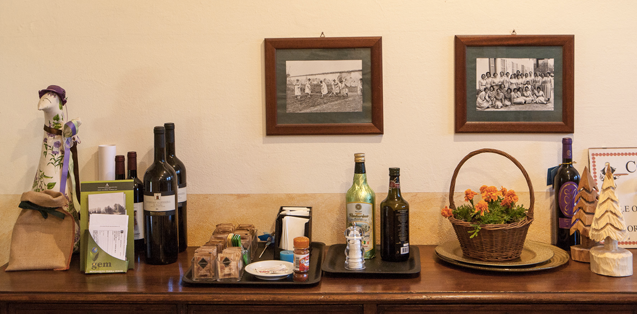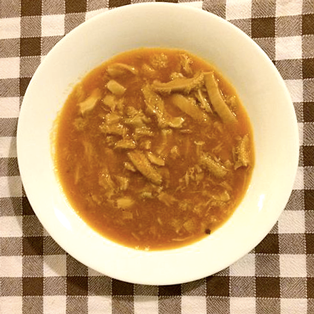The province of Monza and Brianza is not the type of well-defined geographical area that, in other parts of Italy, has meant the evolution of a rich cuisine closely related to the land. Here, in the 18th and 19th centuries, because of the burgeoning system of tenant farming, there was a rapid diminishing in the variety of farming, which resulted in the almost exclusive growing of maize. Everything – fields, waterways, workers – was subordinated to the economic development that has evolved into the way that Brianza works today. The result of the historic and economic development of this part of Lombardy is a cuisine that is sober in character, with dishes deriving from a mixture of plain ingredients associated with a simple, country way of life. The main ingredient of this cuisine is pork – the meat from an animal of which, proverbially, ‘nothing is thrown away’. Every part of the pig is used, boiled, stewed, cured, in sauces, generally served with ‘polenta’, a staple maize ‘porridge’. Brianza dishes are filling, substantial: the aim was to vanquish hunger and get back to work, without worrying too much about the nutritional aspects. According to a simple old saying from the region, ‘la pulenta la cuntenta’ (polenta contents you).
The traditional dishes of Brianza that have stood the test of time, particularly in smaller towns and villages, and in rural communities, have been more recently re-discovered by restaurateurs offering a higher quality of cooking who have created classic dishes able to excite the palates of gourmets and more curious restaurant-goers.
The ‘king’ of traditional Brianza cuisine is ‘cazzoeula’, which can be found well beyond Brianza itself. It is a dish based on the ribs and other, usually discarded parts of the pig – the trotters, the snout and the rind, for example – sometimes with the addition of little ‘salamini’ pork sausages (known locally as ‘verzitt’). Everything is cooked slowly with cabbage, carrots and celery, then served with the omnipresent polenta.
Another dish using the less noble parts of the pig is tripe, known in Brianza as ‘buseca’, from the word ‘buseche’ (guts). The characteristic buseca is a kind of soup, quite liquid, whose ingredients also include tomatoes, carrots, celery and, sometimes, beans.
A simpler dish is ‘el pan moijaa’, a soup made with chopped lard (‘pestada de lard’) and served with bread: the lard, or bacon as an alternative, is finely minced with onion, garlic and parsley, then boiled in water and served on slices of yellow polenta bread. The polenta bread, only produced today by few bakers, is made by mixing the more expensive white flour with maize and rye flour. It was originally widely used with sliced meats but also in milk, for breakfast or evening meal.
A hallmark dish for Monza is risotto with luganega sausage, known also as ‘risotto alla monzese’, a kind of compromise between the cuisines of Monza and Milan. There are many variations, everybody in Monza has their own personal version; the basic ingredient is the typically long, thin, fresh pork sausage to which other ingredients like saffron can be added (though it seems that saffron is not mentioned in the most authentic recipe). Luganega itself is of ancient origin, used by the Romans, who imported it from the southern Italian region of Lucania (now ‘Basilicata’) that gave the sausage its name. It is less widely found today but can be bought in Monza at ‘Il Gourmet’ in Via Passerini or at Angelo Brugola’s little delicatessen in Via Antonietti.
‘Torta paesana’ (village cake) is certainly one of the best-known traditional cakes, another of those simple dishes found throughout the Lombard countryside. It is made with stale bread, soaked in milk and flavoured with cocoa, pine nuts (‘pinoli’), candied fruit and raisins. There are again many local variations.
Keeping the cakes company are two ancient recipes certainly worthy of note, both linked to and named after one of Monza’s patron saints, San Gerardo. San Gerardo biscuits and San Gerardo bread have both been re-invented and revived in more recent times. San Gerardo bread is a sweet bread, traditionally made with sugar, honey and fruit, with the addition, over the years, of candied chestnuts, sultanas and almonds. The rising of the dough lasts 48 hours and is obtained only by using the mother yeast. The origin of the bread is related to a miracle in 1177, when the saint saved the people of Monza from the flooding of the River Lambro by laying his cloak down on the waters. In gratitude, the townsfolk gave San Gerardo this rich bread. It can be bought at the Luzzara cake shop (‘pasticceria’) in Via Buonarotti. You can find San Gerardo biscuits in Via Lecco at the Santini cake shop, where they have been making these dry biscuits for over 150 years. Made without eggs, the biscuits keep very well. As early as the Middle Ages, people living in the Como area took biscuits similar to these when they went on pilgrimages to San Gerardo’s tomb in Monza, had them blessed, brought them back and hung them in their windows at home.
Wine production of a certain level is concentrated on the slopes of Montevecchia. Some years ago, winemaking in the ancient tradition recommenced there, using modern techniques suited to the demands of today’s markets.



